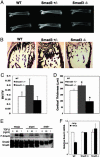TGF-beta regulates the mechanical properties and composition of bone matrix
- PMID: 16354837
- PMCID: PMC1323171
- DOI: 10.1073/pnas.0507417102
TGF-beta regulates the mechanical properties and composition of bone matrix
Abstract
The characteristic toughness and strength of bone result from the nature of bone matrix, the mineralized extracellular matrix produced by osteoblasts. The mechanical properties and composition of bone matrix, along with bone mass and architecture, are critical determinants of a bone's ability to resist fracture. Several regulators of bone mass and architecture have been identified, but factors that regulate the mechanical properties and composition of bone matrix are largely unknown. We used a combination of high-resolution approaches, including atomic-force microscopy, x-ray tomography, and Raman microspectroscopy, to assess the properties of bone matrix independently of bone mass and architecture. Properties were evaluated in genetically modified mice with differing levels of TGF-beta signaling. Bone matrix properties correlated with the level of TGF-beta signaling. Smad3+/- mice had increased bone mass and matrix properties, suggesting that the osteopenic Smad3-/- phenotype may be, in part, secondary to systemic effects of Smad3 deletion. Thus, a reduction in TGF-beta signaling, through its effector Smad3, enhanced the mechanical properties and mineral concentration of the bone matrix, as well as the bone mass, enabling the bone to better resist fracture. Our results provide evidence that bone matrix properties are controlled by growth factor signaling.
Figures





Similar articles
-
The loss of Smad3 results in a lower rate of bone formation and osteopenia through dysregulation of osteoblast differentiation and apoptosis.J Bone Miner Res. 2001 Oct;16(10):1754-64. doi: 10.1359/jbmr.2001.16.10.1754. J Bone Miner Res. 2001. PMID: 11585338
-
Targeted disruption of TGF-beta-Smad3 signaling leads to enhanced neointimal hyperplasia with diminished matrix deposition in response to vascular injury.Circ Res. 2005 Apr 29;96(8):904-12. doi: 10.1161/01.RES.0000163980.55495.44. Epub 2005 Mar 24. Circ Res. 2005. PMID: 15790953
-
Inhibition of TGF-β signaling by 1D11 antibody treatment increases bone mass and quality in vivo.J Bone Miner Res. 2010 Nov;25(11):2419-26. doi: 10.1002/jbmr.139. J Bone Miner Res. 2010. PMID: 20499365
-
A tale of two proteins: differential roles and regulation of Smad2 and Smad3 in TGF-beta signaling.J Cell Biochem. 2007 May 1;101(1):9-33. doi: 10.1002/jcb.21255. J Cell Biochem. 2007. PMID: 17340614 Review.
-
Bone as a Structural Material.Adv Healthc Mater. 2015 Jun 24;4(9):1287-304. doi: 10.1002/adhm.201500070. Epub 2015 Apr 10. Adv Healthc Mater. 2015. PMID: 25865873 Review.
Cited by
-
Hyperactive transforming growth factor-β1 signaling potentiates skeletal defects in a neurofibromatosis type 1 mouse model.J Bone Miner Res. 2013 Dec;28(12):2476-89. doi: 10.1002/jbmr.1992. J Bone Miner Res. 2013. PMID: 23703870 Free PMC article.
-
Molecular and cellular mechanisms underlying the evolution of form and function in the amniote jaw.Evodevo. 2019 Aug 12;10:17. doi: 10.1186/s13227-019-0131-8. eCollection 2019. Evodevo. 2019. PMID: 31417668 Free PMC article. Review.
-
Local Concentrations of TGF-β1 and IGF-1 Appear Determinant in Regulating Bone Regeneration in Human Postextraction Tooth Sockets.Int J Mol Sci. 2023 May 4;24(9):8239. doi: 10.3390/ijms24098239. Int J Mol Sci. 2023. PMID: 37175951 Free PMC article.
-
Smad4 is required for maintaining normal murine postnatal bone homeostasis.J Cell Sci. 2007 Jul 1;120(Pt 13):2162-70. doi: 10.1242/jcs.03466. Epub 2007 Jun 5. J Cell Sci. 2007. PMID: 17550966 Free PMC article.
-
BMP9 attenuates microgravity-related disuse osteoporosis by modulating TGFβ and BMP signaling.NPJ Microgravity. 2025 Aug 1;11(1):50. doi: 10.1038/s41526-025-00510-y. NPJ Microgravity. 2025. PMID: 40751047 Free PMC article.
References
-
- Currey, J. D. (1999) J. Exp. Biol. 202, 2495–2503. - PubMed
-
- Lane, N. E., Yao, W., Kinney, J. H., Modin, G., Balooch, M. & Wronski, T. J. (2003) J. Bone Miner. Res. 18, 2105–2115. - PubMed
-
- Jamsa, T., Rho, J. Y., Fan, Z., MacKay, C. A., Marks, S. C., Jr., & Tuukkanen, J. (2002) J. Biomech. 35, 161–165. - PubMed
Publication types
MeSH terms
Substances
LinkOut - more resources
Full Text Sources
Other Literature Sources
Molecular Biology Databases

